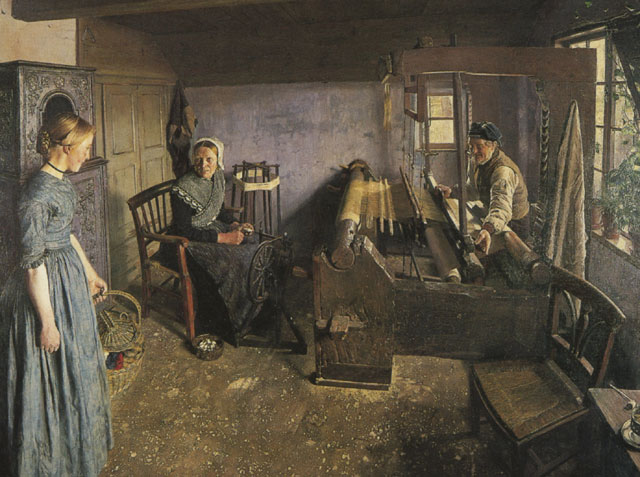
| Linen Weaving |
| HOME - Blanck Introduction - Bremen/Bremerhaven/Lehe |
|
Linen Weaving Johann Friedrick Blanck (1747-1827), his son, Gerhard (1771-1849), and his grandson, Christopher (1817-?), where linen weavers in Lehe, Germany. Lehe is a suburb of Bremerhaven. To see images of Lehe, Bermerhaven and Bremen go to Bremen/Bremerhaven/Lehe now or at the bottom of the page. |
 |
|
| Bernard Winter, Die Webstube, 1896, Landesmuseum für Kunst und Kulturgeschichte Oldenburg, Postcard collection of Maggie Land Blanck, 2005 | |
|
During the middle ages linen was used throughout Europe for shifts, tunics, towels, bedding
and ship's sails.
Linen is made from the fiber of the flax plant. Linen has many advantages as a fiber but the process from seed to fabric is labor intensive. The small oily seeds are sown in the spring. They are sown close together so there is less branching of the plant and minimal weeding is necessary. Flax quickly depletes the soil so it is planted as a rotation crop. | |
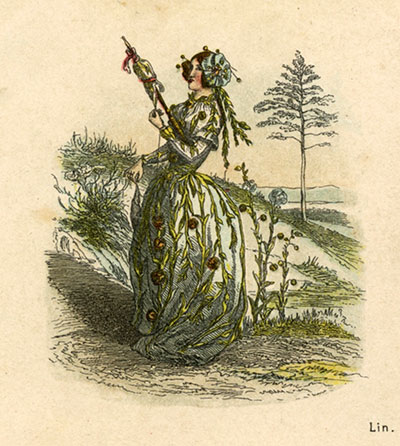 |
Personification of Linen |
| Collection of Maggie Land Blanck, 2013 | |
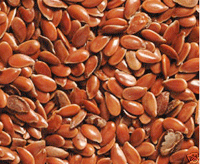 |
Flax seed |
| Collection of Maggie Land Blanck, 2005 | |
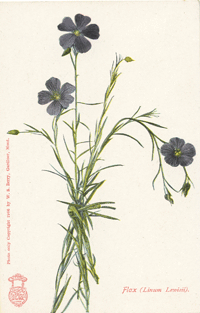 |
Flax plant with flower |
| Postcard collection of Maggie Land Blanck, 2005 | |
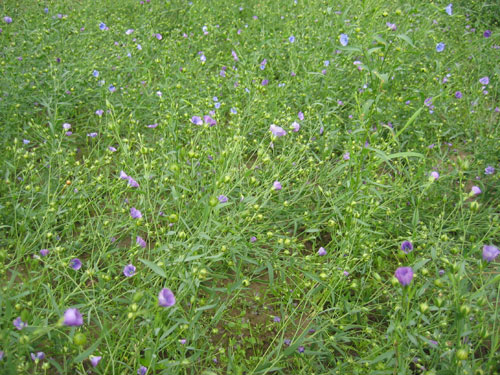 |
Flax in bloom |
| Freilichtmuseum am Kiekeberg, Photo collection of Maggie Land Blanck, 2005 | |
|
The flax plant has a slim stem which grows to a height of between two and three feet and
is ready for harvest about 100 days after sowing. It is usually harvested in July and August.
| |
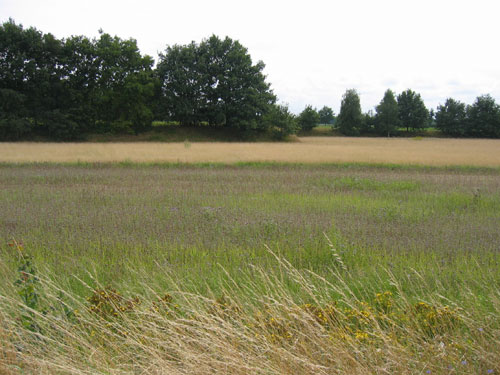 |
Flax field | |||
| Freilichtmuseum am Kiekeberg, Photo collection of Maggie Land Blanck, 2005
| | |||
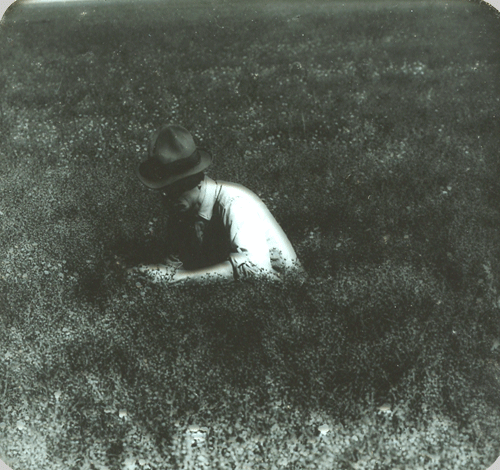 | ||||
| Collection of Maggie Land Blanck, 2009
| Examining a Field of Flax, Saskatchewan, Canada | |||
|
Flax is pulled from the ground with the roots and gathered into bundles.
| |
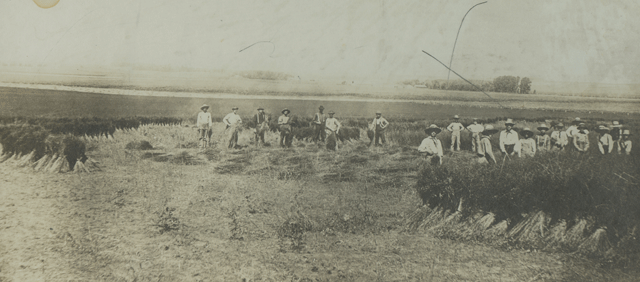 |
|
| Collection of Maggie Land Blanck
This image shows flax harvesting in the sate of Washington, USA. In the United States flax was generally grown for seed. The quality of the fiber was not as fine as that grown in certain European countries. Flax seed oil (known as linseed oil) is used in paints and varnishes. Flax seed is also used in cattle feed.
| |
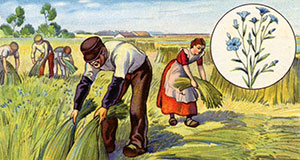 |
Flax harvest, Belgium 1865 |
| Collection of Maggie Land Blanck, 2013 | |
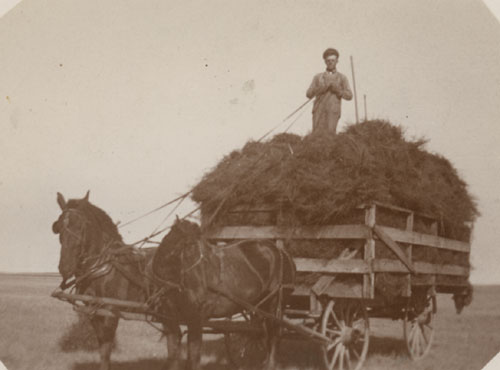 |
An American farmer with a load of flax. | |||
| Postcard collection of Maggie Land Blanck
| | |||
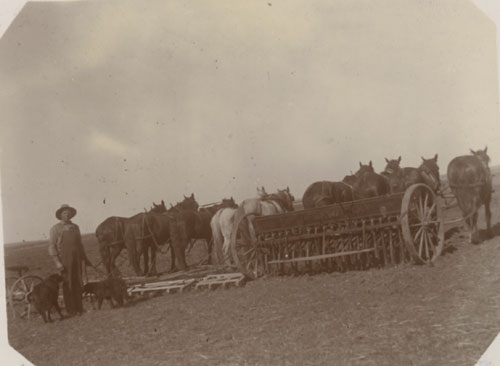 |
An American farmer with teams after the flax had been pulled. | |||
| Postcard collection of Maggie Land Blanck
| | |||
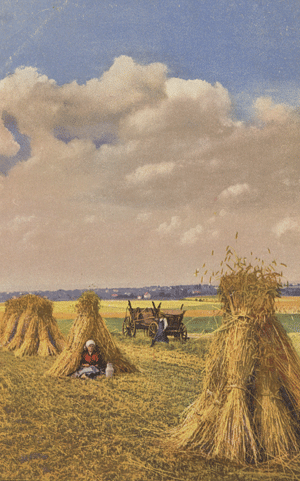 |
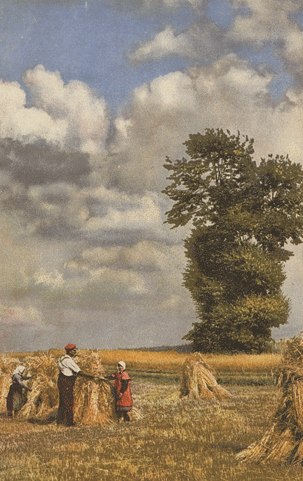 |
| Postcard collection Maggie Land Blanck, 2009
I thought these images represented flax harvest in Germany. However, I am a city person and I was wrong. In August 2010 Gary A Mischke wrote: "When I was a boy, my father occasionally raised flax in Minnesota. During WWII it was an important commodity in the war effort and I remember many barn sized stacks of flax straw bales stacked along the highway south of Windom, Minnesota, destined for war production, although I don't know what was actually made from them.
| |
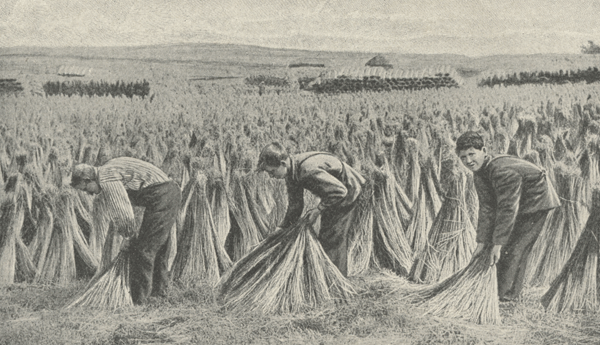 |
|
| Collection of Maggie Land Blanck, 2011
After Gary Mischke informed me that I did not have an image of the flax harvest, I went looking again. "A PROFITABLE CROP: SHEAVES OF FLAX DRYING IN A FIELDI believe that this image represents flax harvest in Europe. Another image in this article is of a flax related process in Belgium and the flip side of the page is entitled "BELGIUM AND THE BELGIANS". Unfortunately, this article is not dated and I do not know the publication - one of the downsides of buying articles torn from old magazines. | |
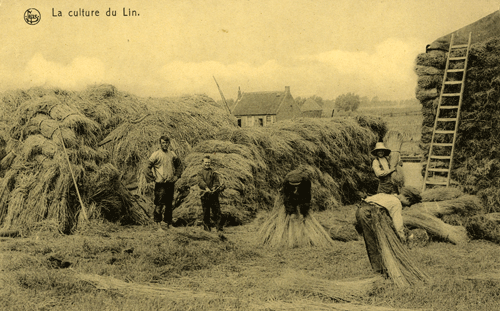 |
|
| Postcard collection of Maggie Land Blanck, 2005
La culture du Lin Printed on black: Entassement | |
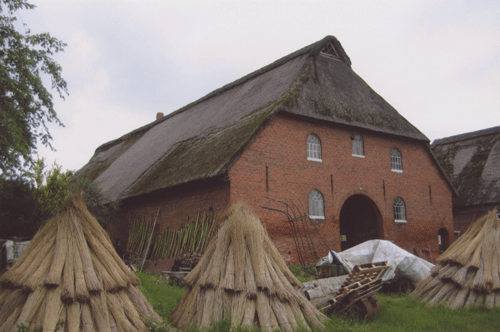 |
|
| Photo Maggie Land Blanck, 2005 In looking for images of flax bundles I took the above picture in 2005. I'm a city girl and missed the finer details. It turns out these bundles are more likely straw or reeds for thatching the roof. In March 2012 Teri Comans kindly set me straight when she wrote: I don't think that the sheaves in the pictures are flax. I think they are more likely to be reeds for thatching. The bunches are too straight and neat. The bottoms are cut not pulled and they have been banged on the ground to make them all uniform. This is a typical thing to do with reeds or straw for thatching.I'm leaving the picture in because I think the old barn is really beautiful. | |
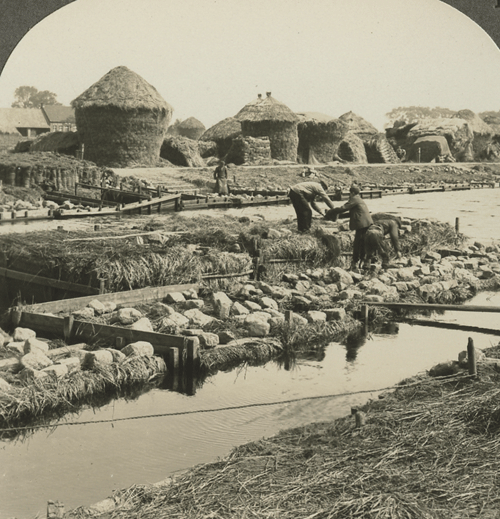 |
|
| Stereo-card collection of Maggie Land Blanck, 2005
Retting Flax Courtai, Belgium | |
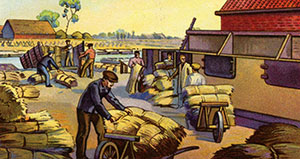 |
Retting flax Belgium 1865 |
| Collection of Maggie Land Blanck, 2013 | |
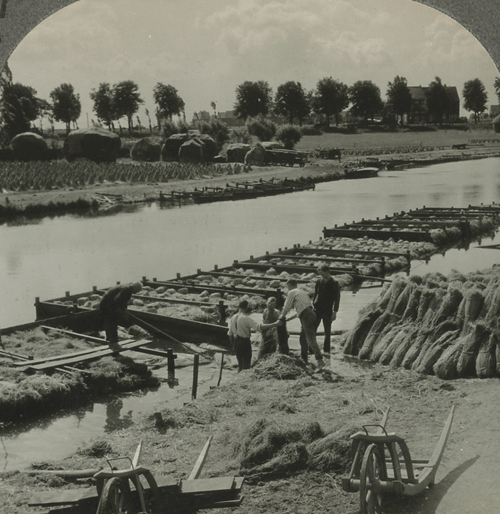 |
|
| Stereo-card collection of Maggie Land Blanck, 2005
Retting Flax Courtai, Belgium In order to separate the fiber from the woody stalk the flax must be retted. Retting allows bacterial action to cause the stalk to loosen and decompose. Needless to say it is a smelly process. There are two methods of retting. The flax can be submerged in a pond or stream for a few days. This method produces a golden or cream colored thread. The flax may also be retted in the field allowing the morning dew to do the same work as the pond. Field retting takes up to six weeks and the flax must be turned periodically. It produces a silver grey thread. When the outer stems are sufficiently decayed the flax is laid out to dry. | |
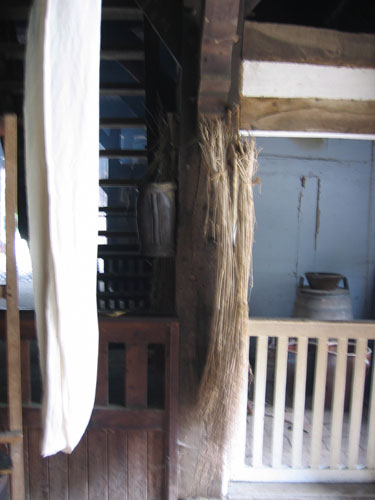 |
Flax bundle and a linen towel |
| Freilichtmuseum am Kiekeberg, Photo collection of Maggie Land Blanck, 2005 | |
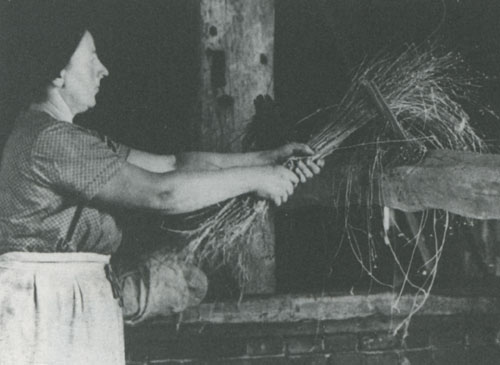 |
Rippling |
| Celle Bomann Museum | |
| The stems are deseeded in a process called rippling. The rippling comb is secured to a bench and the plants are held near the root and pulled through the comb. The seeds fall onto a cloth placed under the bench. The deseeded flax is left to cure until ready to use. | |
| |||||
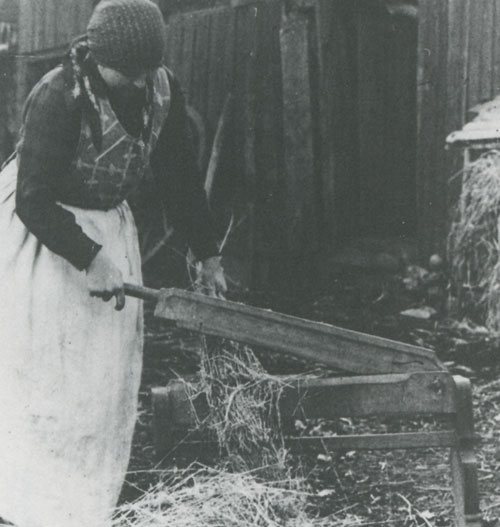 |
Breaking |
| Celle Bomann Museum | |
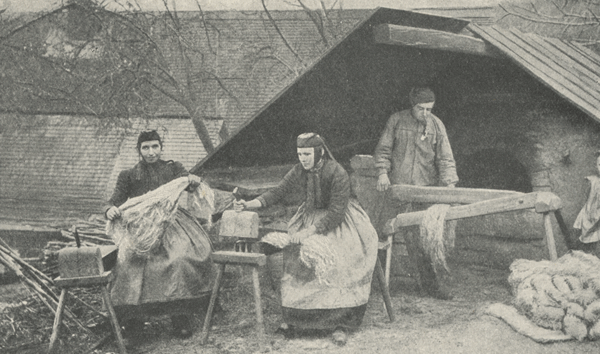 |
|
| Collection of Maggie Land Blanck, 2011
"AFTER THE FLAX HARVEST IN WUTTEMBERG | |
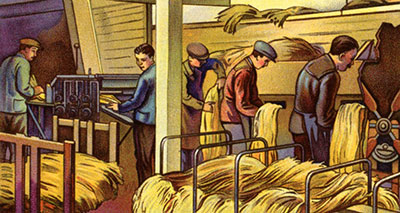 |
Scutching flax, Belgium 1865 |
| Collection of Maggie Land Blanck, 2013 | |
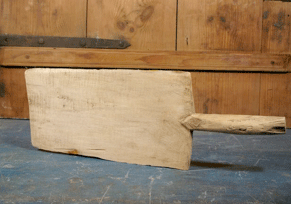 |
Flax comb courtesy of Victory Collectibles |
|
Additional boon is removed when the flax is
beaten against a board with a large wooden knife in a process called scutching.
| |
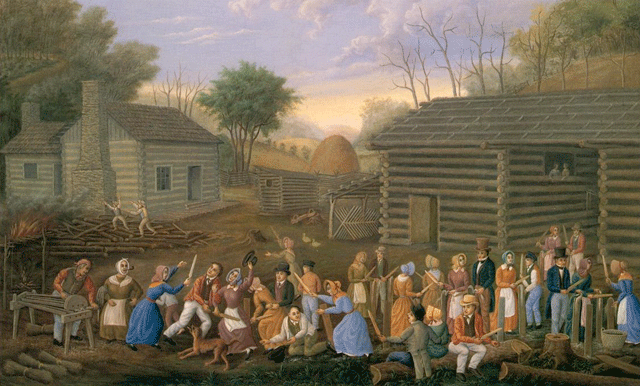 | |
| Flax Scutching Bee by Linton Park 1885, National Gallery, Washington , D. C., Reproduction bought on Ebay, 2009, collection Maggie Land Blanck | |
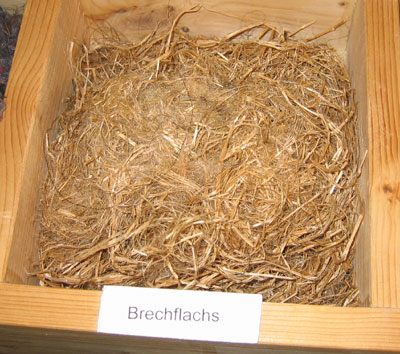 |
Brechflachs (Broken Flax) or Boon This type of residual of the flax was used to stuff seats. |
|
At this stage of the process the remaining material is separated into line, tow and boon. Line is the
long fiber that will eventually be used to weave the linen.
Tow is short fibers that can also be woven into course material or made into
paper and insulation. It was also used to clean the barrels of muskets. Boon can also be used as mulch or burned as fuel.
| |
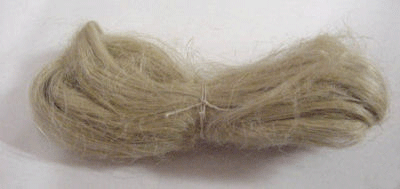 |
Tow Light blonds were called tow headed or flaxen haired. |
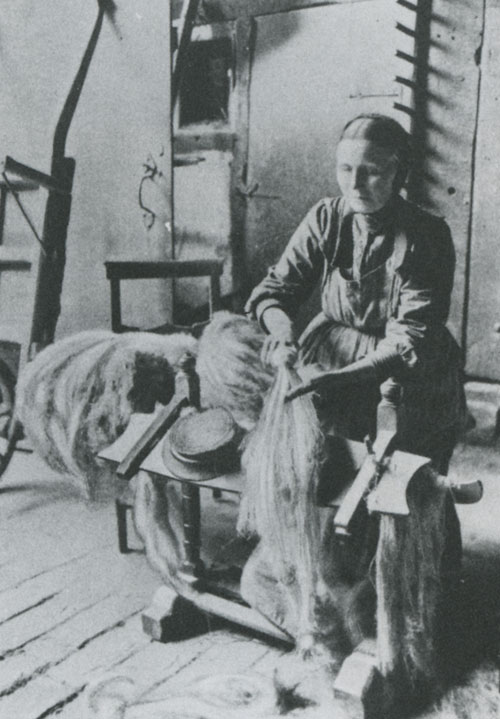 |
Hackling |
| Celle Bomann Museum | |
| The final process, called hackling, is when the fiber is drawn through a series of combs to remove any remaining boom and tow. Over 85% of the plant has been removed in the process of arriving at the end product called strick. |
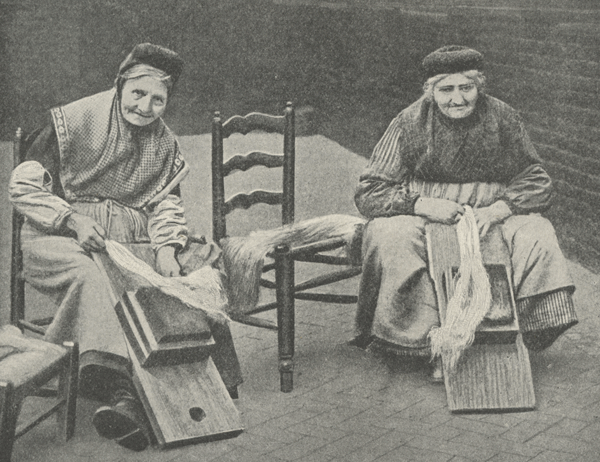 |
|
| Collection of Maggie Land Blanck, 2011
"STAGES IN A HOME INDUSTRY OF IMMEMORIAL ANTIQUITY | |
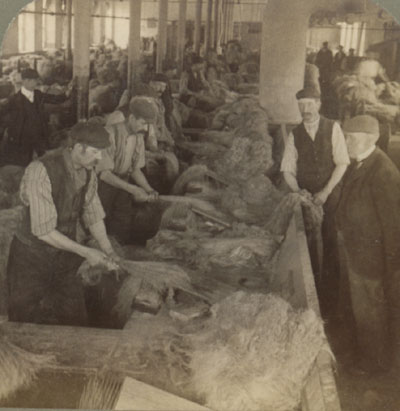 |
Hackling, Belfast Ireland, 1905 From back of card: "The work is in one sense rough and heavy, in another sense very delicate. An unskilled man, drawing a bundle of long flax fibres over those ugly, sharp teeth, might easily break them so that the result would be a mere handful of broken remnants. An expert worker knows how to handle the stuff so as to comb out each course fibre into a bundle of smaller, parallel fibres, with the least possible waste in the way of unevenness and breakage." |
| Stereo card collection of Maggie Land Blanck | |
|
The long thin fibers resembling human hair have to be handled carefully to keep them from tangling. A distaff is used to keep the fibers separate and in line during spinning. The flax wheel is traditionally a small wheel. The flax needs to be continually moistened while spinning.
| |
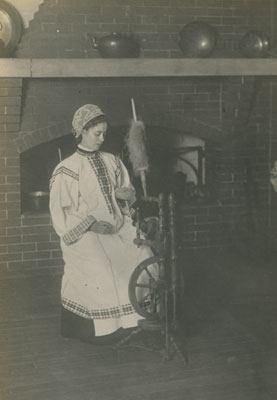 |
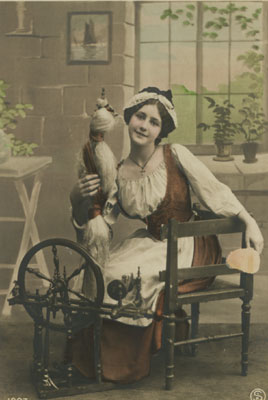 |
| Postcard collection of Maggie Land Blanck Young ladies with spinning wheels and distaffs | |
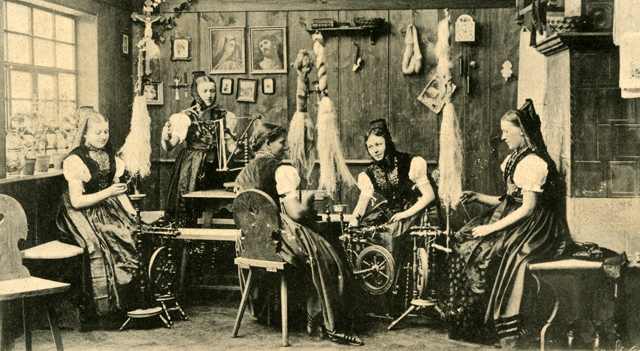 |
|
| Postcard collection of Maggie Land Blanck, 2005
Schwarzwalder spinnstube | |
|
After the thread is spun the yarn, now called linen, is stretched and boiled to set the twist put in by the spinning.
Flax is a valuable crop not only for the linen. The seeds are harvested for linseed oil. Linseed oil has been used for wood treatment, paint, animal fodder, lamp oil, cough medicine, laxatives and other medicinal purposes. Linoleum was make from linseed oil and ground cork.
|
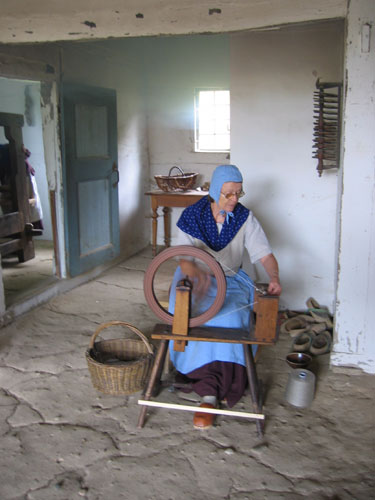 |
Spinning linen |
| Freilichtmuseum am Kiekeberg. Photo collection Maggie Land Blanck, 2005 Spinnen und Winnen | |
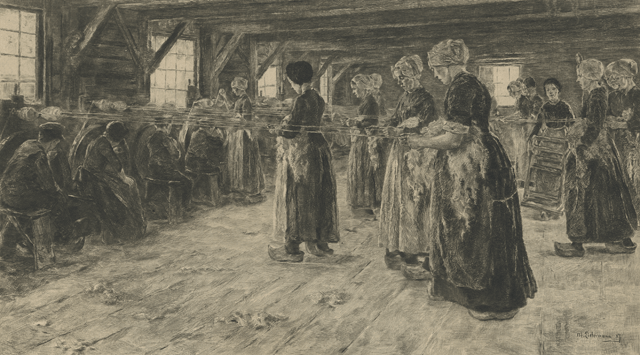
| |
| Collection of Maggie Land Blanck Flax-Spinners, 1887, by Max Lieberman (German Artist, born 1847) | |
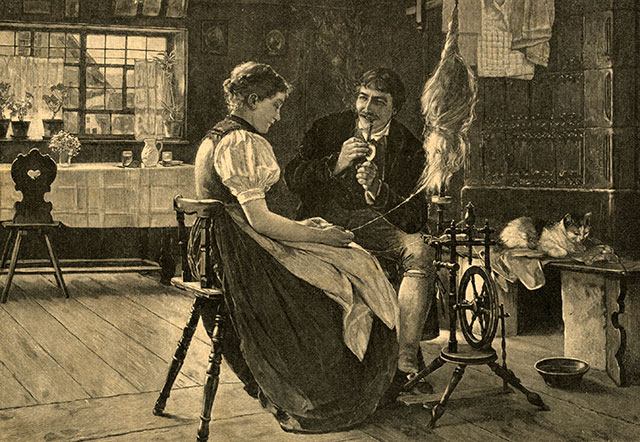 |
|
| Print collection of Maggie Land Blanck, 2013
| |
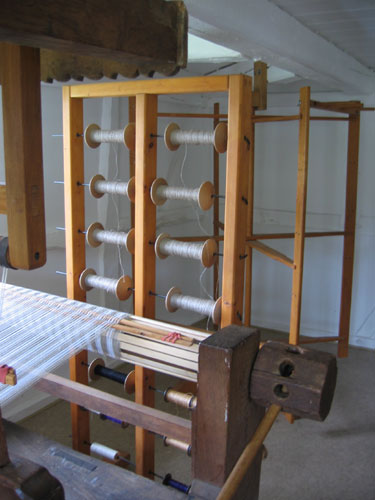 |
Linen thread on spools |
| Freilichtmuseum am Kiekeberg. Photo collection Maggie Land Blanck, 2005 | |
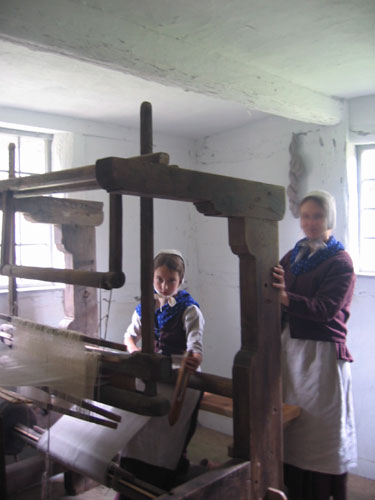 |
Weaving linen |
| Freilichtmuseum am Kiekeberg. Photo collection Maggie Land Blanck, 2005 | |
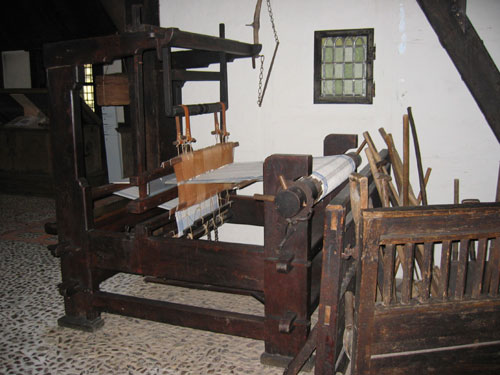 |
Linen Loom |
| Celle Bomann Museum. Photo collection Maggie Land Blanck, 2005 | |
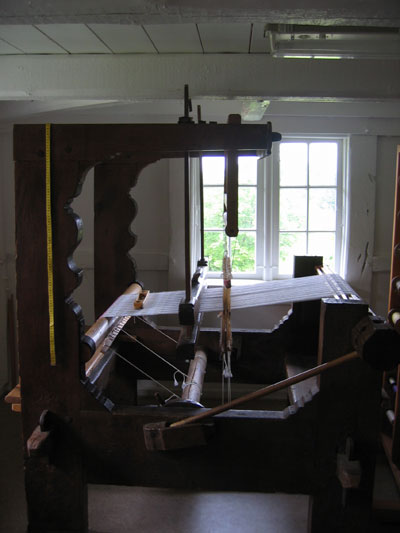 |
Linen Loom |
| Freilichtmuseum am Kiekeberg. Photo collection Maggie Land Blanck, 2005 | |
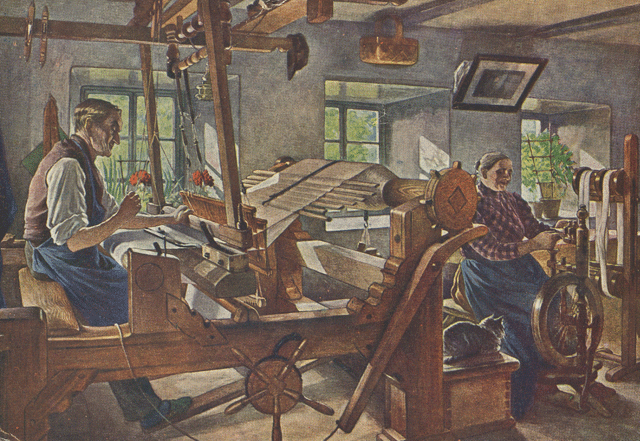 |
|
| Postcard collection Maggie Land Blanck, 2009 Linnen weaving and spinning. | |
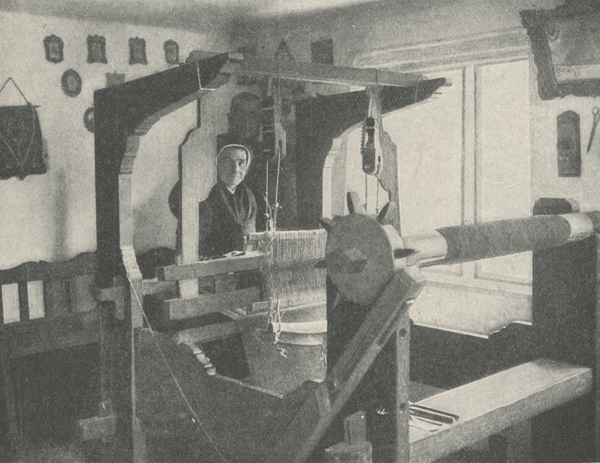 |
|
| Collection of Maggie Land Blanck, 2011
A woman at her linen loom in Monchgut, Island of Rugen, Germany. | |
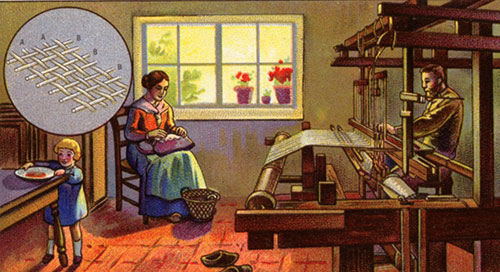 |
Hand weaving, the flax industry in Belgium 1865 |
| Collection of Maggie Land Blanck, 2013 | |
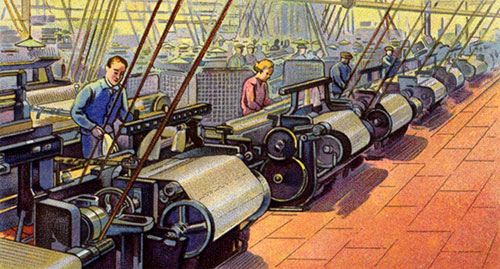 |
Factory weaving, the flax industry in Belgium 1865 |
| Collection of Maggie Land Blanck, 2013 | |
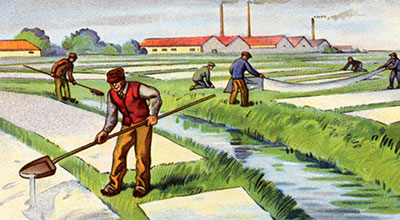 |
Bleaching, the flax industry in Belgium 1865 |
| Collection of Maggie Land Blanck, 2013 | |
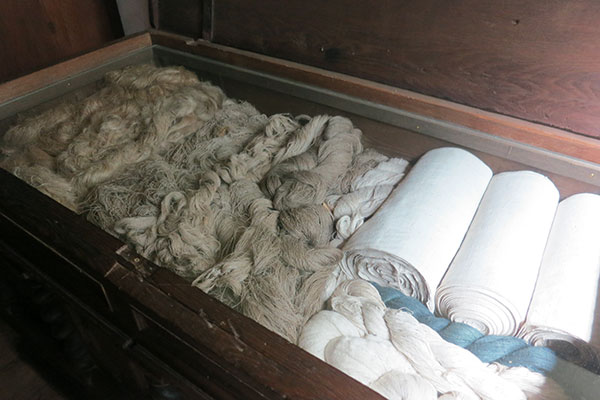 |
|
| Photo Maggie Land Blanck, 2012
Unbleached, bleached and died line thread and bleached linen cloth, Museum Cloppenburg, Germany. | |
| Stahlstown, Pennsylvania has a flax Scutching festival every September. There is a lot of info on the Internet about this festival. | |
| HOME | |
| Blanck Introduction | |
| Bremen/Bremerhaven/Lehe | |
| Occupations | |
| If you have any suggestions, corrections, information, copies of documents, or photos that you would like to share with this site, please contact me at maggie@maggieblanck.com | |
| RETURN TO TOP OF PAGE | |
|
Please feel free to link to this web page. You may use images on this web page provided that you give proper acknowledgement to this web page and include the same acknowledgments that I have made to the provenance of the image. Please be judicious. Please don't use all the images. You may quote my original text from this web page and use any cited quotes on this web page provided you give proper acknowledgement to this web page and include the same acknowledgments that I have made to the provenance of the information. Please do not cut and paste the whole page. You may NOT make use any of the images or information on this web page for your personal profit. You may NOT claim any content of this web page as your original idea. Thanks, Maggie |
| Copyright by Maggie Land Blanck - This page was created in 2004 - Latest update, October 2015 |